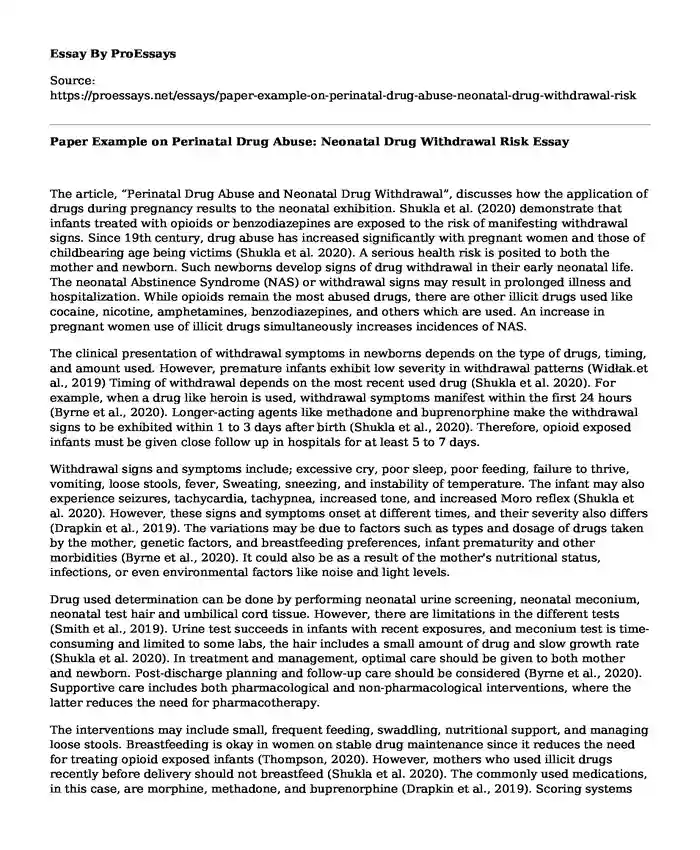The article, “Perinatal Drug Abuse and Neonatal Drug Withdrawal”, discusses how the application of drugs during pregnancy results to the neonatal exhibition. Shukla et al. (2020) demonstrate that infants treated with opioids or benzodiazepines are exposed to the risk of manifesting withdrawal signs. Since 19th century, drug abuse has increased significantly with pregnant women and those of childbearing age being victims (Shukla et al. 2020). A serious health risk is posited to both the mother and newborn. Such newborns develop signs of drug withdrawal in their early neonatal life. The neonatal Abstinence Syndrome (NAS) or withdrawal signs may result in prolonged illness and hospitalization. While opioids remain the most abused drugs, there are other illicit drugs used like cocaine, nicotine, amphetamines, benzodiazepines, and others which are used. An increase in pregnant women use of illicit drugs simultaneously increases incidences of NAS.
The clinical presentation of withdrawal symptoms in newborns depends on the type of drugs, timing, and amount used. However, premature infants exhibit low severity in withdrawal patterns (Widlak.et al., 2019) Timing of withdrawal depends on the most recent used drug (Shukla et al. 2020). For example, when a drug like heroin is used, withdrawal symptoms manifest within the first 24 hours (Byrne et al., 2020). Longer-acting agents like methadone and buprenorphine make the withdrawal signs to be exhibited within 1 to 3 days after birth (Shukla et al., 2020). Therefore, opioid exposed infants must be given close follow up in hospitals for at least 5 to 7 days.
Withdrawal signs and symptoms include; excessive cry, poor sleep, poor feeding, failure to thrive, vomiting, loose stools, fever, Sweating, sneezing, and instability of temperature. The infant may also experience seizures, tachycardia, tachypnea, increased tone, and increased Moro reflex (Shukla et al. 2020). However, these signs and symptoms onset at different times, and their severity also differs (Drapkin et al., 2019). The variations may be due to factors such as types and dosage of drugs taken by the mother, genetic factors, and breastfeeding preferences, infant prematurity and other morbidities (Byrne et al., 2020). It could also be as a result of the mother's nutritional status, infections, or even environmental factors like noise and light levels.
Drug used determination can be done by performing neonatal urine screening, neonatal meconium, neonatal test hair and umbilical cord tissue. However, there are limitations in the different tests (Smith et al., 2019). Urine test succeeds in infants with recent exposures, and meconium test is time-consuming and limited to some labs, the hair includes a small amount of drug and slow growth rate (Shukla et al. 2020). In treatment and management, optimal care should be given to both mother and newborn. Post-discharge planning and follow-up care should be considered (Byrne et al., 2020). Supportive care includes both pharmacological and non-pharmacological interventions, where the latter reduces the need for pharmacotherapy.
The interventions may include small, frequent feeding, swaddling, nutritional support, and managing loose stools. Breastfeeding is okay in women on stable drug maintenance since it reduces the need for treating opioid exposed infants (Thompson, 2020). However, mothers who used illicit drugs recently before delivery should not breastfeed (Shukla et al. 2020). The commonly used medications, in this case, are morphine, methadone, and buprenorphine (Drapkin et al., 2019). Scoring systems like Lipsitz tool are used to guide in initiation and weaning of opioid therapy. Infants are then discharged once they have been weaned off from pharmacotherapy.
The NAS presents symptoms similar to those of sepsis, endocrine, metabolic disturbances, and hypoxic-ischaemic encephalopathy hence need a proper and careful diagnosis (Shukla et al. 2020). The situation needs the care of multidisciplinary teams like nurses and physical therapists where social services and child life are included inpatient care (Byrne et al., 2020).
References
Byrne, P. J., Foss, K., Clarke, D., Wismark, J., & Cardinal, K. (2020). Re; Newborns exposed to opioids need mothers more than NICU. CMAJ Group. https://www.cmaj.ca/content/re-newborns-exposed-opioids-need-mothers-more-nicu
Drapkin, Z., Franchek-Roa, K., Srinivas, G. L., Buchi, K. F., & Miescier, M. J. (2019). Is my baby normal? A review of seemingly worrisome but normal newborn signs, symptoms and behaviors. The American Journal of Emergency Medicine, 37(6), 1153-1159. https://static1.squarespace.com/static/54694fa6e4b0eaec4530f99d/t/5dd82bb035e8b009c3821581/1574448049479/Is+my+baby+normal%3F+A+review+of+seemingly+worrisome+but+normal+newborn+signs%2C+symptoms+and+behaviors.pdf
Shukla, S., Zirkin, L. B., & Gomez Pomar, E. (2020). Perinatal drug abuse and neonatal drug withdrawal. Pediatrics. https://uknowledge.uky.edu/cgi/viewcontent.cgi?article=1304&context=pediatrics_facpub
Smith, J. G., Rogowski, J. A., Schoenauer, K. M., & Lake, E. T. (2018). Infants in drug withdrawal: A national description of nurse workload, infant acuity, and parental needs. J Perinat Neinatal Nurs. https://pubmed.ncbi.nlm.nih.gov/29373422/
Thompson, A. L. (2020). Cuddling and the Born-Addicted Infant: Implementation of volunteer-based cuddling programs for babies experiencing Neonatal Abstinence Syndrome in the Neonatal Intensive Care Unit. Journal of Eastern Kentucky University. https://encompass.eku.edu/cgi/viewcontent.cgi?article=1773&context=honors_theses
Widlak, K., Wójtowicz, A., Scislak, R., Drankowska, J., Kos, M., Szuster, A., . & Furmaga-Jablonska, W. (2019). Ischemic stroke as a rare cause of seizures in a newborn–case report. Journal of Education, Health and Sport, 9(7), 76-84.
Cite this page
Paper Example on Perinatal Drug Abuse: Neonatal Drug Withdrawal Risk. (2023, Sep 25). Retrieved from https://proessays.net/essays/paper-example-on-perinatal-drug-abuse-neonatal-drug-withdrawal-risk
If you are the original author of this essay and no longer wish to have it published on the ProEssays website, please click below to request its removal:
- Breast Cancer Disease Analysis Paper
- Essay on Controversial Issues in Health
- 12-Week Weight Loss Program Paper Example
- Should Continuing Nursing Education Be Mandatory for All Nurses? Essay
- Essay Example on White Privilege in America
- Technology Trends in Nursing and Healthcare Essay
- Essay on US War on Terror: Targeted Killings, Mass Surveillance, & Detention







